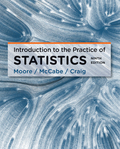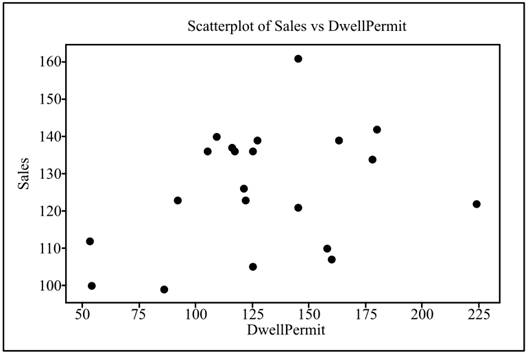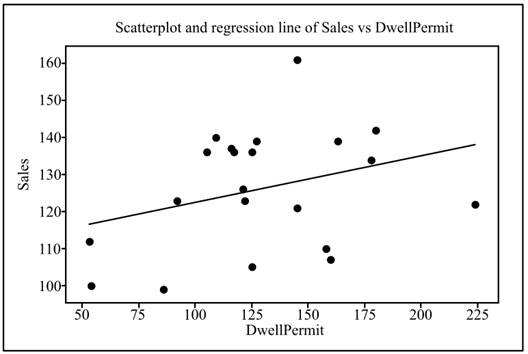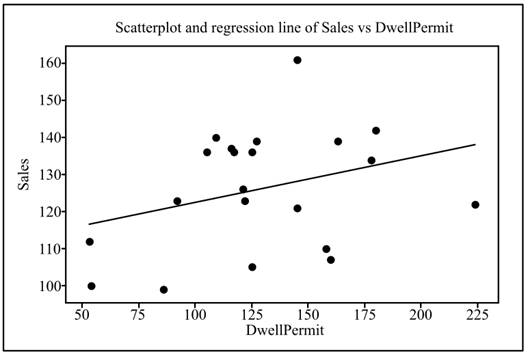
Concept explainers
(a)
To graph: The
(a)
Explanation of Solution
Graph: To draw the scatterplot for the provided data set, the below steps are followed in Minitab software.
Step 1: Open the “MEIS” file in Minitab software.
Step 2: Go to Graph
Step 3: Choose the option “Simple” and click “OK”.
Step 4: Select “Sales” as Y variables and “Dwellpermit” as X variables.
Step 5: Click “OK” twice.
The scatterplot is obtained as:

To explain: The relationship between the variables and the presence of the outliers.
Answer to Problem 144E
Solution: Though the relationship between the variables is very weak, but there is no outlier in the data set.
Explanation of Solution
(b)
To find: The least-squares regression line for the data.
(b)
Answer to Problem 144E
Solution: The least-squares regression line is obtained as

Explanation of Solution
Calculation: To draw the regression line and obtain the sketch of the regression line, the below steps are followed in the Minitab software.
Step 1: Right click on the obtained graph in the part (a).
Step 2: Go to Add
Step 3: Click on “Linear” under the menu “Model Order” and tick the “Fit intercept”.
Step 4: Click on “OK” to obtain the regression line.
The obtained regression equation is
Graph: The below graph shows the regression line.

(c)
To explain: The slope of the obtained line.
(c)
Answer to Problem 144E
Solution: The slope can be interpreted as if there is an increase of 1unit of the variable, issued permit for dwelling then there is an increase of 0.1263 units in the value of the variable sales.
Explanation of Solution
(d)
To explain: The intercept of the line.
(d)
Answer to Problem 144E
Solution: The intercept can be interpreted as the value of the response variable when the value of the explanatory variable is zero. As the value of the response variable is 109.8 for the zero issued permits, it is appropriate to use the intercept for explaining the relationship between the variables.
Explanation of Solution
(e)
The sales for an index of 224 dwelling permits.
(e)
Answer to Problem 144E
Solution: The predicted value of the sales is 138.0912.
Explanation of Solution
The predicted value can be calculated as:
(f)
To find: The residual value for Canada.
(f)
Answer to Problem 144E
Solution: The obtained value of the residual is
Explanation of Solution
Calculation: The sale for the Canada is provided as 122. The residual value for the sales for Canada whose index of dwelling permits is 224 is calculated as:
(g)
The percentage of variability in sales is explained by dwelling permit.
(g)
Answer to Problem 144E
Solution: The explained percentage of variability in sales is 10.30%.
Explanation of Solution
Therefore, the proportion of variation that is explained by the explanatory variables of the model is 10.30%.
Want to see more full solutions like this?
Chapter 2 Solutions
Introduction to the Practice of Statistics
- 2. Hypothesis Testing - Two Sample Means A nutritionist is investigating the effect of two different diet programs, A and B, on weight loss. Two independent samples of adults were randomly assigned to each diet for 12 weeks. The weight losses (in kg) are normally distributed. Sample A: n = 35, 4.8, s = 1.2 Sample B: n=40, 4.3, 8 = 1.0 Questions: a) State the null and alternative hypotheses to test whether there is a significant difference in mean weight loss between the two diet programs. b) Perform a hypothesis test at the 5% significance level and interpret the result. c) Compute a 95% confidence interval for the difference in means and interpret it. d) Discuss assumptions of this test and explain how violations of these assumptions could impact the results.arrow_forward1. Sampling Distribution and the Central Limit Theorem A company produces batteries with a mean lifetime of 300 hours and a standard deviation of 50 hours. The lifetimes are not normally distributed—they are right-skewed due to some batteries lasting unusually long. Suppose a quality control analyst selects a random sample of 64 batteries from a large production batch. Questions: a) Explain whether the distribution of sample means will be approximately normal. Justify your answer using the Central Limit Theorem. b) Compute the mean and standard deviation of the sampling distribution of the sample mean. c) What is the probability that the sample mean lifetime of the 64 batteries exceeds 310 hours? d) Discuss how the sample size affects the shape and variability of the sampling distribution.arrow_forwardA biologist is investigating the effect of potential plant hormones by treating 20 stem segments. At the end of the observation period he computes the following length averages: Compound X = 1.18 Compound Y = 1.17 Based on these mean values he concludes that there are no treatment differences. 1) Are you satisfied with his conclusion? Why or why not? 2) If he asked you for help in analyzing these data, what statistical method would you suggest that he use to come to a meaningful conclusion about his data and why? 3) Are there any other questions you would ask him regarding his experiment, data collection, and analysis methods?arrow_forward
- Businessarrow_forwardWhat is the solution and answer to question?arrow_forwardTo: [Boss's Name] From: Nathaniel D Sain Date: 4/5/2025 Subject: Decision Analysis for Business Scenario Introduction to the Business Scenario Our delivery services business has been experiencing steady growth, leading to an increased demand for faster and more efficient deliveries. To meet this demand, we must decide on the best strategy to expand our fleet. The three possible alternatives under consideration are purchasing new delivery vehicles, leasing vehicles, or partnering with third-party drivers. The decision must account for various external factors, including fuel price fluctuations, demand stability, and competition growth, which we categorize as the states of nature. Each alternative presents unique advantages and challenges, and our goal is to select the most viable option using a structured decision-making approach. Alternatives and States of Nature The three alternatives for fleet expansion were chosen based on their cost implications, operational efficiency, and…arrow_forward
- The following ordered data list shows the data speeds for cell phones used by a telephone company at an airport: A. Calculate the Measures of Central Tendency from the ungrouped data list. B. Group the data in an appropriate frequency table. C. Calculate the Measures of Central Tendency using the table in point B. 0.8 1.4 1.8 1.9 3.2 3.6 4.5 4.5 4.6 6.2 6.5 7.7 7.9 9.9 10.2 10.3 10.9 11.1 11.1 11.6 11.8 12.0 13.1 13.5 13.7 14.1 14.2 14.7 15.0 15.1 15.5 15.8 16.0 17.5 18.2 20.2 21.1 21.5 22.2 22.4 23.1 24.5 25.7 28.5 34.6 38.5 43.0 55.6 71.3 77.8arrow_forwardII Consider the following data matrix X: X1 X2 0.5 0.4 0.2 0.5 0.5 0.5 10.3 10 10.1 10.4 10.1 10.5 What will the resulting clusters be when using the k-Means method with k = 2. In your own words, explain why this result is indeed expected, i.e. why this clustering minimises the ESS map.arrow_forwardwhy the answer is 3 and 10?arrow_forward
 MATLAB: An Introduction with ApplicationsStatisticsISBN:9781119256830Author:Amos GilatPublisher:John Wiley & Sons Inc
MATLAB: An Introduction with ApplicationsStatisticsISBN:9781119256830Author:Amos GilatPublisher:John Wiley & Sons Inc Probability and Statistics for Engineering and th...StatisticsISBN:9781305251809Author:Jay L. DevorePublisher:Cengage Learning
Probability and Statistics for Engineering and th...StatisticsISBN:9781305251809Author:Jay L. DevorePublisher:Cengage Learning Statistics for The Behavioral Sciences (MindTap C...StatisticsISBN:9781305504912Author:Frederick J Gravetter, Larry B. WallnauPublisher:Cengage Learning
Statistics for The Behavioral Sciences (MindTap C...StatisticsISBN:9781305504912Author:Frederick J Gravetter, Larry B. WallnauPublisher:Cengage Learning Elementary Statistics: Picturing the World (7th E...StatisticsISBN:9780134683416Author:Ron Larson, Betsy FarberPublisher:PEARSON
Elementary Statistics: Picturing the World (7th E...StatisticsISBN:9780134683416Author:Ron Larson, Betsy FarberPublisher:PEARSON The Basic Practice of StatisticsStatisticsISBN:9781319042578Author:David S. Moore, William I. Notz, Michael A. FlignerPublisher:W. H. Freeman
The Basic Practice of StatisticsStatisticsISBN:9781319042578Author:David S. Moore, William I. Notz, Michael A. FlignerPublisher:W. H. Freeman Introduction to the Practice of StatisticsStatisticsISBN:9781319013387Author:David S. Moore, George P. McCabe, Bruce A. CraigPublisher:W. H. Freeman
Introduction to the Practice of StatisticsStatisticsISBN:9781319013387Author:David S. Moore, George P. McCabe, Bruce A. CraigPublisher:W. H. Freeman





